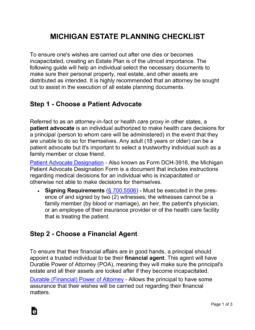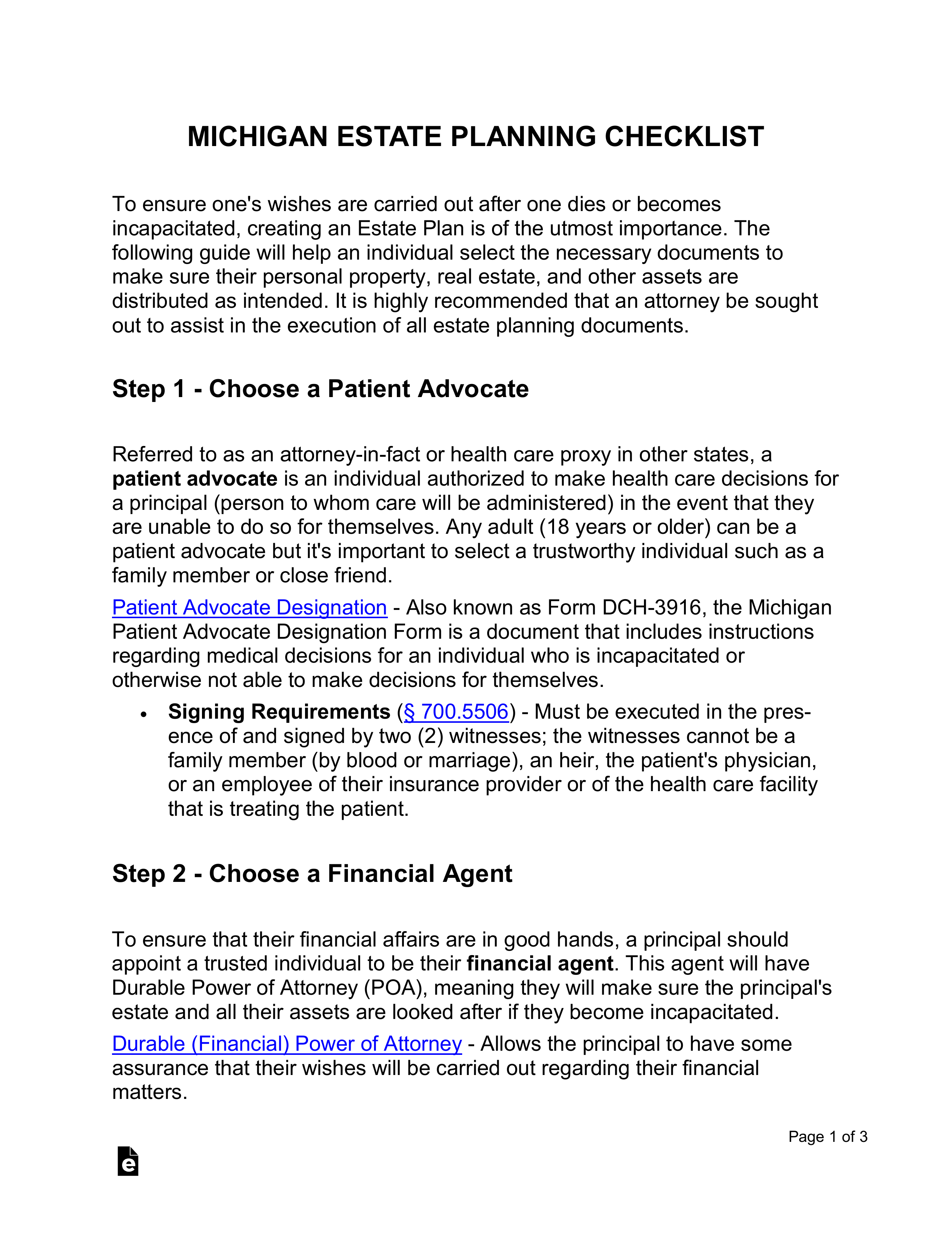Updated March 05, 2024
A Michigan estate planning checklist covers the preparations an individual should make so their medical preferences are honored if they become incapacitated, and their estate is distributed according to their wishes if they die. It can be a valuable tool for those who are in the process of setting up their medical and financial representatives for when they are unable to make decisions on their own. Should the individual become disabled or incapacitated, having a Patient Advocate Designation allows a trustworthy representative to make decisions on their behalf. A Power of Attorney is an essential document in that the named financial agent can carry out any financial duties as per the principal’s instructions. Perhaps the most vital estate planning instruments are the Last Will and Testament and the Revocable Living Trust. These documents outline the testator’s decisions regarding the distribution of their estate and assets after they die.
How to Create an Estate Plan in Michigan (6 steps)
- Choose a Patient Advocate
- Choose a Financial Agent
- Make a List of All Assets and Real Estate
- Select Beneficiaries
- Write a Living Trust or Last Will and Testament
- Storing the Documents
To ensure one’s wishes are carried out after one dies or becomes incapacitated, creating an estate plan is of the utmost importance. The following guide will help an individual select the necessary documents to make sure their personal property, real estate, and other assets are distributed as intended. It is highly recommended that an attorney be sought out to assist in the execution of all estate planning documents.
1. Choose a Patient Advocate
- Signing Requirements – Must be executed in the presence of and signed by two (2) witnesses; the witnesses cannot be a family member (by blood or marriage), an heir, the patient’s physician, or an employee of their insurance provider or of the health care facility that is treating the Patient.[1]
2. Choose a Financial Agent
Durable (Financial) Power of Attorney – Allows the principal to have some assurance that their wishes will be carried out regarding their financial matters.
- Signing Requirements – The POA must be signed by the principal and two (2) witnesses OR acknowledged by the principal before a notary public (completion of Certificate of Acknowledgement is required).[2]
Financial Powers Allowed:
- Banking;
- Government benefits;
- Investments;
- Retirement plan;
- Taxes;
- Insurance;
- Real estate;
- Personal property;
- Legal advice and proceedings; and
- Estate plan.
3. Make a List of All Assets and Real Estate
4. Select Beneficiaries
5. Write a Living Trust or Last Will and Testament
For the beneficiaries to receive their inheritance, a document must be drafted by the principal outlining precise instructions in regard to the distribution of assets.
Last Will and Testament – A Last Will and Testament, or simply a Will, is a common tool for a person to outline their intentions of property distribution after death. This document provides instructions for an executor (person who handles the Will after the individual’s death) to hand over the testator’s (individual who created the document) assets to each named beneficiary. The estate will go through probate upon the testator’s death; the process typically takes seven (7) months to a year unless there are significant federal taxes owed, in which case it may take longer.
- Signing Requirements – Testator (or an individual on their behalf) and two (2) witnesses.[3]
Living Trust (Revocable) – Similar to a will, a Revocable Living Trust manages a grantor’s (creator of trust) assets, but has the added benefits of avoiding probate court and not being made public after the grantor’s death. The grantor transfers ownership of their property to the Trust (usually making themselves, or a trusted individual, trustee) and appoints a successor trustee as the representative of the Trust once the grantor dies.
- Signing Requirements – No signing requirements mentioned; other trust-creation requirements are set forth in the linked statutes.[4]
6. Storing the Documents
Michigan Estate Planning Laws
- Patient Advocate – § 700.5506(-5520)
- Durable Power of Attorney – § 700.5101(-5505)
- Last Will and Testament – § 700.2501(-2519)
- Living Trust (Revocable) – § 700.7601(-7615)


